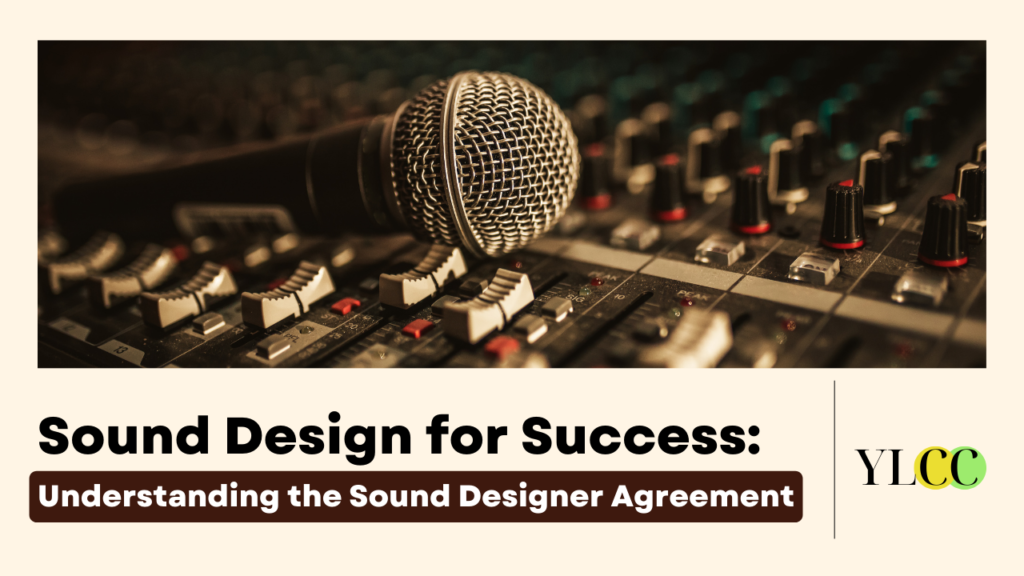
Introduction
A Sound Designer Agreement is a legal contract that outlines the terms and conditions between a sound designer and a client or employer regarding the creation, delivery, and usage of audio elements for a specific project. Sound designers are professionals responsible for creating and manipulating sound effects, music, and other audio components to enhance the overall auditory experience of various media productions, such as films, video games, commercials, or theatrical performances. The agreement typically covers key aspects such as the scope of work, compensation, ownership of intellectual property rights, deadlines, and any other relevant details to ensure a clear understanding between the parties involved.
In the agreement, the scope of work is a crucial element, detailing the specific responsibilities of the sound designer and the expectations of the client regarding the delivered audio assets. Compensation terms, including the amount to be paid, payment schedule, and any additional expenses, are clearly defined to avoid misunderstandings. Intellectual property clauses address issues related to the ownership of the created sound elements, specifying whether the client will have exclusive rights, how the sound designer can showcase their work in their portfolio, and any potential royalties or residuals. Deadlines and delivery milestones are established to ensure timely project completion, and provisions for revisions or modifications may also be included. A well-drafted Sound Designer Agreement helps safeguard the interests of both parties and provides a solid foundation for a successful collaboration in the field of audio production.
Team YLCC, through this article, brings you a guide on understanding the Sound Designer Agreement!
The Key Clauses
Scope of Work
The “Scope of Work” clause in a Sound Designer Agreement is a pivotal section that precisely defines the tasks, responsibilities, and deliverables expected from the sound designer throughout the project. This clause serves as a roadmap, outlining the specific details of the sound designer’s contribution to the overall project and establishing a clear understanding between the parties involved.
In this clause, the scope of work typically addresses the types of audio elements to be created, manipulated, or enhanced by the sound designer. It may specify whether the sound designer is responsible for producing sound effects, composing music, designing atmospheric soundscapes, or other related tasks. By explicitly defining the nature of the work, the clause helps prevent misunderstandings and ensures that both parties share a common vision for the project.
Furthermore, the Scope of Work may include details about the technical specifications and quality standards that the sound designer is expected to meet. For example, it could specify the file formats, sample rates, or other technical requirements necessary to seamlessly integrate the audio elements into the final project.
Intellectual Property Rights
The “Intellectual Property Rights” clause in a Sound Designer Agreement addresses the ownership and control of the creative and intellectual assets produced by the sound designer during the project. This clause is crucial for both parties involved, as it defines who has the rights to use, distribute, and control the audio elements created, and it helps prevent potential disputes over ownership.
Key aspects covered in the Intellectual Property Rights clause include:
- Ownership: The clause specifies whether the client or the sound designer retains ownership of the intellectual property associated with the audio assets. In some cases, the agreement might grant exclusive rights to the client, meaning they have full control over the use and distribution of the sound elements. Alternatively, it could outline shared ownership arrangements where both parties have specific rights to the created work.
- Usage Rights: This part of the clause details how the client can use the audio assets. For example, it may specify whether the client has the right to use the sound elements in a specific project, across different platforms, or for a designated period. The agreement may also address whether the sound designer can showcase the work in their portfolio or use it for self-promotion.
- Royalties and Residuals: If applicable, the Intellectual Property Rights clause may discuss any ongoing financial arrangements related to the use of the sound elements. This could include royalties or residuals, where the sound designer receives additional compensation for continued use or exploitation of the audio assets beyond the initial project.
Delivery and Deadlines
The “Delivery and Deadlines” clause in a Sound Designer Agreement is a crucial section that outlines the timeline and schedule for the completion and delivery of the sound design work. This clause helps manage expectations, ensures timely project completion, and provides a framework for both parties to track progress throughout the engagement.
Key components of the Delivery and Deadlines clause include:
- Project Timeline: This clause specifies the overall timeline for the project, including the start date and the anticipated completion date. It may also include any intermediate milestones or checkpoints to assess progress at different stages of the project. A well-defined timeline helps both the sound designer and the client align their expectations and plan accordingly.
- Delivery Milestones: The clause may break down the project into specific deliverables or milestones, indicating when certain aspects of the sound design work are expected to be completed and submitted. This detailed breakdown assists in project management and allows both parties to track progress more effectively.
- Revisions and Modifications: Some agreements include provisions for revisions or modifications to the sound elements. This section may outline the number of revisions allowed, the process for requesting changes, and any associated timelines for the sound designer to implement revisions. This ensures that the final deliverables meet the client’s expectations.
- Consequences of Delays: The clause may also address the consequences of delays, specifying whether there are penalties for missed deadlines or if there are mechanisms for extending timelines under certain circumstances. This helps incentivize timely performance and provides a framework for addressing unexpected challenges that may arise during the project.
Conclusion
A well-drafted Sound Designer Agreement serves as a vital blueprint for a collaborative and successful engagement between the sound designer and the client. The key clauses, such as the Scope of Work, Intellectual Property Rights, and Delivery and Deadlines, provide a comprehensive framework that not only delineates responsibilities and expectations but also fosters transparency, clear communication, and mutual understanding.
As the agreement addresses the intricacies of the sound design process, including the specific tasks, compensation details, ownership of intellectual property, and project timelines, it lays the groundwork for a harmonious and productive relationship. Clear definitions of the scope of work prevent misunderstandings, the Intellectual Property Rights clause ensures fair ownership arrangements, and the Delivery and Deadlines clause establishes a roadmap for timely project completion.
Both parties can navigate the complexities of the sound design collaboration with confidence, knowing that their respective interests are protected by meticulously considering and negotiating these clauses. Ultimately, a well-structured Sound Designer Agreement not only safeguards the legal and financial aspects of the engagement but also contributes to the artistic and creative success of the project, ensuring a harmonious and mutually beneficial partnership.
Disclaimer: This article is for information purposes only. You are advised to consult a legal professional for drafting such crucial documents for your business.
This article has been written by Team YLCC. For any other queries, reach out to us at: queries.ylcc@gmail.com






